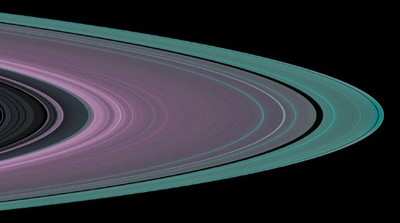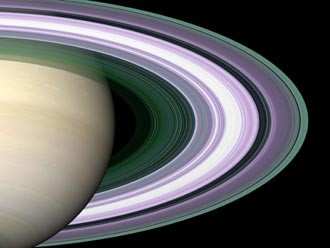Cassini Radio Signals Decipher Saturn Ring Structure
The Cassini spacecraft has obtained the most detailed look ever
at Saturn’s rings, including the B ring, which has eluded
previous robotic explorers. Its structure seems remarkably
different from its two neighbors, rings A and C.

The origin of Saturn’s rings is a mystery. The rings
are an enormous, complex structure. From edge-to-edge, the ring
system would not even fit in the distance between Earth and the
Moon. The seven main rings are labeled in the order they were
discovered. From the planet outward, they are D, C, B, A, F,
G and E.
During a recent radio experiment, Cassini mapped this structure
with clarity never before available. This is the first of
many such observations Cassini will be conducting over the
summer.
“The structure of those remarkable rings is a sight to
behold. All ring features appear to be populated by a broad
range of particle sizes that extend to many meters in diameter at
the upper end,” said Dr. Essam Marouf, Cassini radio science
team member and professor of electrical engineering, San Jose State
University, San Jose, CA.

Marouf said that at the lower end, particles of about 5
centimeters (roughly 2 inches) in diameter or less seem to be
scarce in ring B and inner ring A. In rings C and outer ring
A, particles of less than about 5 centimeters (2 inches) in
diameter seem to be abundant.
Cassini found that the inner and outer parts of ring B contain
rings that are hundreds of kilometers wide (hundreds of miles) and
vary greatly in the amount of material they contain. A thick,
5,000-kilometer-wide (3,100-mile) core contains several bands with
ring material that is nearly four times as dense as that of ring A
and nearly 20 times as dense as that of ring C.
The dramatically varying structure of ring B is in sharp
contrast to the relatively flat structure of ring A or the gentle,
wavy structure of ring C, where many dense, narrow and sharp-edged
ringlets permeate its outer part.
Cassini also detected more than 40 wavy features called
“density waves” in ring A, many near its outer region,
close to the moons orbiting just outside the ring. The
density wave observations will tell more about the ring surface
mass density, its vertical thickness and other physical
properties.
“A marvelous array of waves, caused by gravitational
interactions with nearby moons, has been uncovered throughout ring
A,” said Marouf. “We also see a major density
wave in the dense ring B. Some of these waves have been seen
in Voyager and other Cassini observations, but not in this large
number and not with this exceptional clarity.”
Cassini conducted this first radio occultation observation of
Saturn's rings, atmosphere and ionosphere on May 3, 2005. An
occultation means that if you watch Cassini from Earth, Cassini
would appear occulted, or hidden, behind the rings. During a
radio occultation, Cassini sends a radio signal from the spacecraft
through the rings to Earth. Scientists then watch how the
strength of the radio signal is affected as the signal passes
through ring material. The denser a ring is, the weaker the
signal received. The experiment helps scientists map the
distribution of the amount of ring material and determine the ring
particle sizes.

The occultation was the first ever to use three radio signals of
different frequencies (called Ka, X and S) transmitted
simultaneously from a spacecraft to Earth-receiving stations of
NASA’s Deep Space Network. Ring particles of different
sizes affect each frequency differently.
The Cassini tour was specifically designed to optimize the
geometry of the first radio occultation experiment and seven other
occultations scheduled from May to September 2005. These
observations are at the heart of Cassini's fundamental science
objectives of characterizing and understanding Saturn and its ring
system. During its lifetime, Cassini will obtain 20 radio
occultations and 80 stellar occultations, providing far more
detailed knowledge of the ring structures.
 ANN's Daily Aero-Linx (04.15.24)
ANN's Daily Aero-Linx (04.15.24) Classic Aero-TV: 'No Other Options' -- The Israeli Air Force's Danny Shapira
Classic Aero-TV: 'No Other Options' -- The Israeli Air Force's Danny Shapira Aero-News: Quote of the Day (04.15.24)
Aero-News: Quote of the Day (04.15.24) Airborne 04.16.24: RV Update, Affordable Flying Expo, Diamond Lil
Airborne 04.16.24: RV Update, Affordable Flying Expo, Diamond Lil ANN's Daily Aero-Term (04.16.24): Chart Supplement US
ANN's Daily Aero-Term (04.16.24): Chart Supplement US





